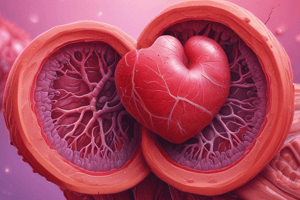Podcast
Questions and Answers
What is coronary artery disease (CAD)?
What is coronary artery disease (CAD)?
A narrowing or blockage of coronary arteries usually due to plaque buildup.
What causes atherosclerosis?
What causes atherosclerosis?
The exact cause is unknown but may start with damage or injury to the inner layer of an artery. Possible causes include high triglycerides, high blood pressure, smoking, insulin resistance, high cholesterol, diabetes, obesity, and inflammation.
What role do low-density lipoproteins (LDL) play in the body?
What role do low-density lipoproteins (LDL) play in the body?
- Transport cholesterol and triglycerides into cells (correct)
- Increase blood pressure
- Decrease blood flow
- None of the above
What is the normal level for low-density lipoproteins (LDL)?
What is the normal level for low-density lipoproteins (LDL)?
Match the following lipid profiles with their normal levels:
Match the following lipid profiles with their normal levels:
Having high blood pressure is a modifiable risk factor for coronary artery disease.
Having high blood pressure is a modifiable risk factor for coronary artery disease.
Being male is a nonmodifiable risk factor for coronary artery disease.
Being male is a nonmodifiable risk factor for coronary artery disease.
The process of blood flow obstruction leads to ______________ (depending on severity).
The process of blood flow obstruction leads to ______________ (depending on severity).
What is angina pectoris?
What is angina pectoris?
What is the first method of treatment for coronary artery disease?
What is the first method of treatment for coronary artery disease?
Flashcards are hidden until you start studying
Study Notes
Coronary Artery Disease (CAD)
- Narrowing or blockage of coronary arteries, usually due to plaque buildup.
- Coronary arteries supply oxygen-rich blood to the heart.
- Plaque limits how much blood can reach the heart.
Coronary Atherosclerosis
- Buildup of fats, cholesterol, and other substances on artery walls.
- This buildup is called plaque.
- Plaque can cause arteries to narrow, blocking blood flow.
- Plaque can lead to a blood clot.
Causes of Atherosclerosis
- Exact cause is unknown.
- May start with damage or injury to the inner layer of an artery.
- Damage may be caused by:
- High triglycerides
- High blood pressure
- Smoking
- Insulin resistance
- High cholesterol
- Diabetes
- Obesity
- Inflammation from an unknown cause or from diseases such as arthritis
Pathophysiology of Atherosclerosis
- Low-density lipoprotein molecules (LDL) become oxidized by oxygen free radicals.
- Oxidized LDL comes in contact with an artery wall, causing damage.
- The body's immune system sends specialized white blood cells (macrophages and T-lymphocytes) to absorb oxidized-LDL, forming foam cells.
- These white blood cells cannot process the oxidized-LDL and eventually rupture.
- The artery becomes inflamed.
- Cholesterol plaque causes muscle cells to enlarge and form a hard cover over the affected area.
- The hard cover narrows the artery, reduces blood flow, and increases blood pressure.
Lipid Profile
- Lipoproteins: LDL and HDL
- LDL: (normal level, less than 130 mg/dL)
- Primary transporters of cholesterol and triglycerides into the cell.
- Deposit these substances in the walls of arterial vessels.
- HDL: (normal range in men, 35 to 65 mg/dL; in women, 35 to 85 mg/dL)
- Have a protective action.
- Transport cholesterol away from the tissue and cells of the arterial wall to the liver for excretion.
- Cholesterol: (normal level, less than 200 mg/dL, High: = 240 mg/dL)
- Triglycerides: (normal range, 40 to 150 mg/dL)
- Composed of free fatty acids and glycerol, stored in the tissue and are a source of energy.
Stages of Atherosclerosis
| Stage | Description |
|---|---|
| Healthy artery | Normal artery with no plaque build up |
| Plaque forms | Small deposits of plaque begin to form on the artery walls |
| Cholesterol deposited | Plaque starts to build up in the artery |
| Build-up begins | Plaque continues to build up restricting blood flow |
Normal Heart and Artery vs. Artery with Plaque Buildup
| Normal Heart and Artery | Artery with Plaque Buildup |
|---|---|
| * Normal artery wall |
- Red blood cells
- Coronary artery
- Heart | * Artery wall
- Red blood cells
- Plaque
- Narrowed coronary artery
- Heart
- Fat |
Physiologic Factors that Increase Risk of Atherosclerosis
Modifiable
- Having diabetes
- Tobacco smoking (increases risk by 200% after several pack years)
- High blood pressure
- Elevated serum C-reactive protein concentrations
Nonmodifiable
- Advanced age
- Male sex
- Having close relatives who have had some complication of atherosclerosis (e.g., coronary heart disease or stroke)
- Genetic abnormalities (e.g. familial hypercholesterolemia)
Lesser or Uncertain
- Being obese (in particular central obesity)
- Sedentary lifestyle
- High carbohydrate intake
- Elevated serum levels of triglycerides
- Stress
Signs and Symptoms of Atherosclerosis
- Depend on the degree of narrowing of the arterial lumen, thrombus formation and obstruction of blood flow.
- Inadequate supply of blood leads to oxygen deprivation in muscle (ischemia).
- Angina pectoris, chest pain brought about by myocardial ischemia, usually caused by coronary atherosclerosis.
- If blood supply decreases significantly and for a longer period, myocardial infarction can occur.
- Damaged myocardium is replaced by scar tissue, causing various degrees of myocardial dysfunction.
- Inadequate cardiac output and heart failure can occur.
Treatment of Atherosclerosis
- Non-pharmacological means (cessation of smoking and regular exercise) are usually the first line of treatment.
- If non-pharmacological methods do not work, medicines are usually the next step.
- Statins:
- Widely prescribed for treating atherosclerosis.
- Examples: lovastatin, simvastatin, and fluvastatin.
- Action: block cholesterol synthesis, lower LDL and triglyceride levels, and increase HDL.
- Nicotinic acids:
- Another class of medications used to treat atherosclerosis.
Studying That Suits You
Use AI to generate personalized quizzes and flashcards to suit your learning preferences.




